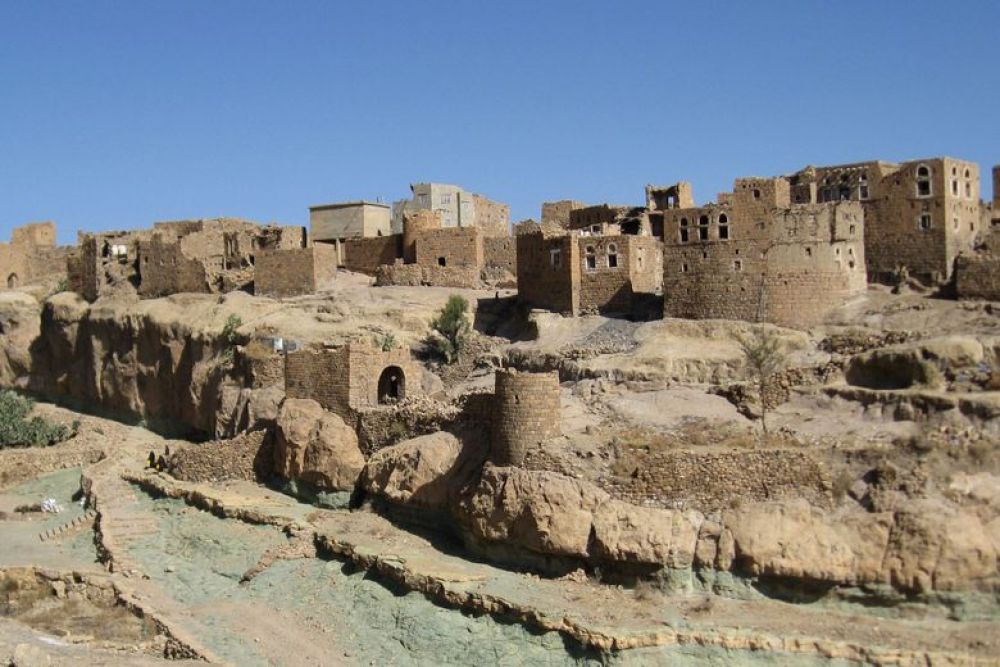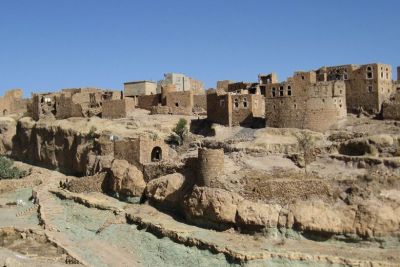

Visiting the Al-Saleh Mosque is an opportunity to experience the religious and architectural grandeur of Yemen. Completed in 2008, this modern mosque stands as a symbol of unity and is one of the largest in Yemen, with a capacity of over 40,000 worshippers. Its design features a fusion of Yemeni and Islamic architecture with six grand minarets each reaching 100 meters high, and the interior is adorned with beautiful lamps and intricate calligraphy. The mosque also includes a library, a lecture hall, and a medical clinic. Visitors are usually welcomed outside of prayer times, and it's advised to dress conservatively. Photography is allowed, but discretion should be practiced, especially during prayer times.
The Old City of Sana'a, a UNESCO World Heritage site, offers a journey back in time with its unique multi-story buildings and ancient structures. Stroll through the labyrinthine streets past homes that look like gingerbread houses built of rammed earth and decorated with geometric patterns. The architecture here truly reflects the Yemeni way of life that has been preserved for centuries. The bustling Souk al-Milh (Salt Market) is perfect for buying local spices, Yemeni honey, and handicrafts. Take a guided tour to learn more about the area's history and culture, visit the Bab al-Yemen (The Gate of Yemen), and do not miss out on sampling local coffee and dishes.
Dar al-Hajar, or the Rock Palace, stands tall as an iconic symbol of Yemeni heritage. Situated atop a rock formation in Wadi Dhahr Valley, this former royal residence built in the 1930s offers an impressive glimpse into Yemen's past. The edifice amazes visitors with its defying gravity position and traditional Yemeni architecture. The house is spread over five levels and its interior features rooms carved out of the rock. Exploring its terraces and rooms provides insights into Yemen's royal history and affords panoramic views of the lush valley below. The palace is often bustling with local families and photographers, making it a cultural hub as well as a historical one. Remember to come prepared with comfortable shoes for climbing the rocky path to the palace.
Jabal an Nabi Shu'ayb, standing as the highest mountain in Yemen and the Arabian Peninsula, poses a challenge for avid climbers and hikers. This peak, allegedly the resting place of the prophet Shu'ayb, offers not only a spiritual experience but also an invigorating physical challenge. The hike up the mountain is strenuous, so proper preparation and a guide are highly recommended. The path unveils diverse flora and fauna unique to the region, and as you ascend, the landscape offers breathtaking views that are a reward in themselves. Once at the summit, one would find traditional shrines and can enjoy a sense of tranquility and accomplishment while gazing at the magnificent views of the surrounding countryside.
Housed in a former palace, the National Museum of Yemen in Sana’a is a treasure trove of history and culture. The museum boasts a vast collection of artifacts spanning the ancient kingdoms of Saba, Qataban, Hadhramaut, and Himyar. There are exhibits on the pre-Islamic and Islamic periods, including rare manuscripts and traditional costumes. The museum provides a comprehensive overview of Yemen's rich cultural heritage through well-organized displays and informative placards. In addition to artifacts, the museum's architecture and design offer an unspoken narrative about the evolution of Yemen’s historical fabric. Translators or guided tours can enrich the experience, as most signage is in Arabic.
The Shaharah Bridge, nestled high in the mountains of northwest Yemen, is an engineering marvel of the 17th century. Built to connect two villages across a deep gorge, this limestone bridge stands as a testimony to the ingenuity of medieval Yemeni engineering. The bridge measures about 20 meters long and offers stunning views of the surrounding landscape and the sheer drop below. Local legend says that the bridge was constructed in a single night, which adds to its mystique. The journey to Shaharah can be challenging but the experience is surely rewarding, bringing a sense of adventure for travelers and showcasing the incredible heritage of the region. Aside from the bridge, Shaharah itself is a delightful village with stone houses and terraced fields, allowing visitors to see the traditional Yemeni lifestyle.
The Haraz Mountains offer a scenic escape into the heart of Yemen's rugged landscape. Ideal for outdoor enthusiasts, the hiking trails let you explore terraced agricultural fields, witness traditional mountain village life, and enjoy breathtaking views. The mountain range possesses a unique charm with fortified villages and ancient pathways that tell a story of a bygone era. Travelers are advised to trek with local guides who know the trails and historical context. The hikes can vary from moderate walks to strenuous treks, depending on your route and fitness level. The region is also known for its rich coffee culture, so you can visit local farmers and sample some of the world's finest coffee right from the source.
Yemen is the birthplace of Coffea Arabica, and the coffee trail tour is an immersive experience for any coffee lover. The tour takes you through the rich, fertile lands where the coffee cherries are grown and harvested. Along the journey, visitors can learn firsthand from farmers about traditional growing practices that have been passed down through generations and witness the meticulous process of harvesting and drying coffee beans. Tastings are an essential part of the tour, where participants savor the distinctive rich, fruity notes of Yemeni coffee. A visit to a local roastery might also be included, where you can observe the roasting process that brings out the flavor of the beans. This experience not only indulges the senses but also provides insight into the economic and cultural importance of coffee in Yemen.
Diving into Yemeni cuisine offers a wealth of flavor and tradition, and a cooking class is the perfect way to engage with the local culture. Traditional Yemeni dishes such as Saltah, a meat-based stew with fenugreek froth, or Mandi, a succulent rice and meat dish cooked in a tandoor, can be learned in these hands-on sessions. Classes typically include a market visit to source fresh ingredients while exploring the local food culture. Under the guidance of a local chef, participants will learn how to blend spices and herbs endemic to the region to create authentic Yemeni flavors. These classes offer more than just culinary skills; they're a window into the Yemeni way of life and a chance to interact with the community.
Embarking on a photography tour of Sana’a is a visual feast for professional and amateur photographers alike. With a professional photographer guide, participants will visit photogenic spots around the city, including the famed Old City with its historic buildings, bustling markets, and captivating cityscapes. The tour focuses on capturing the essence of Sana'an life and its architecture, allowing for unique shots that tell a story. Guides offer tips on technique and composition to help photographers take stunning images. With the play of light at sunrise or sunset, the photographic opportunities are spectacular, promising a rewarding collection of memorable shots. The photography tour is an excellent way to document the beauty of Sana’a while learning from a local expert.
